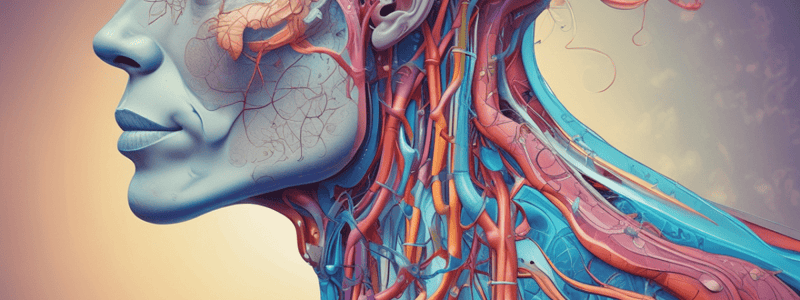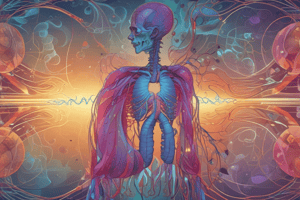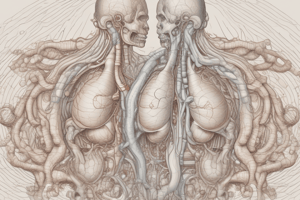Podcast
Questions and Answers
What is the primary function of the lungs in relation to the tissues?
What is the primary function of the lungs in relation to the tissues?
- To regulate body temperature
- To send oxygen to the tissues (correct)
- To send carbon dioxide to the tissues
- To remove bicarbonate from the blood
What is the name of the molecule formed when oxygen binds to hemoglobin?
What is the name of the molecule formed when oxygen binds to hemoglobin?
- Hemoglobin dioxide
- Deoxyhemoglobin
- Oxyhemoglobin (correct)
- Carbaminohemoglobin
How does the majority of oxygen get delivered to the tissues?
How does the majority of oxygen get delivered to the tissues?
- Through dissolved oxygen in the blood
- Through the plasma itself
- Through binding to hemoglobin (correct)
- Through the carbonic anhydrase enzyme
What is the name of the enzyme that helps convert carbon dioxide and water back into bicarbonate and protons in the lungs?
What is the name of the enzyme that helps convert carbon dioxide and water back into bicarbonate and protons in the lungs?
What is the role of bicarbonate in the transport of carbon dioxide from the tissues to the lungs?
What is the role of bicarbonate in the transport of carbon dioxide from the tissues to the lungs?
What is the name of the molecule formed when carbon dioxide binds directly to hemoglobin?
What is the name of the molecule formed when carbon dioxide binds directly to hemoglobin?
How does carbon dioxide primarily get transported from the tissues to the lungs?
How does carbon dioxide primarily get transported from the tissues to the lungs?
What is the result of the reaction between bicarbonate and protons in the lungs?
What is the result of the reaction between bicarbonate and protons in the lungs?
What is the function of hemoglobin?
What is the function of hemoglobin?
What happens when hemoglobin binds to protons?
What happens when hemoglobin binds to protons?
What is the result of the competition between oxygen and protons for hemoglobin?
What is the result of the competition between oxygen and protons for hemoglobin?
What is the effect of carbon dioxide and protons on hemoglobin?
What is the effect of carbon dioxide and protons on hemoglobin?
What is the name of the effect where carbon dioxide and protons decrease the affinity of hemoglobin for oxygen?
What is the name of the effect where carbon dioxide and protons decrease the affinity of hemoglobin for oxygen?
What is the name of the effect where oxygen increases the affinity of hemoglobin for carbon dioxide and protons?
What is the name of the effect where oxygen increases the affinity of hemoglobin for carbon dioxide and protons?
What is the result of cooperativity in hemoglobin?
What is the result of cooperativity in hemoglobin?
What happens to the slope of the oxygen binding curve as the partial pressure of oxygen increases?
What happens to the slope of the oxygen binding curve as the partial pressure of oxygen increases?
At what point does the oxygen binding curve level off?
At what point does the oxygen binding curve level off?
What is the key factor that determines the direction of the reaction between hemoglobin and oxygen?
What is the key factor that determines the direction of the reaction between hemoglobin and oxygen?
What is a high location in the body where oxygen is dissolved in blood?
What is a high location in the body where oxygen is dissolved in blood?
What is the difference between oxygen levels in the lungs and the thigh muscle?
What is the difference between oxygen levels in the lungs and the thigh muscle?
Why would you want to increase oxygen delivery to a tissue?
Why would you want to increase oxygen delivery to a tissue?
What is the effect of high CO2 and protons on hemoglobin's affinity for oxygen?
What is the effect of high CO2 and protons on hemoglobin's affinity for oxygen?
Where is the Bohr effect more relevant in the body?
Where is the Bohr effect more relevant in the body?
What is the result of the Bohr effect on oxygen delivery?
What is the result of the Bohr effect on oxygen delivery?
What is the vertical distance between the green and blue lines representing?
What is the vertical distance between the green and blue lines representing?
What is the relationship between high protons and pH?
What is the relationship between high protons and pH?
What is the effect of the Bohr effect on the oxygen dissociation curve?
What is the effect of the Bohr effect on the oxygen dissociation curve?
Why is the Bohr effect important in the body?
Why is the Bohr effect important in the body?
What is the shape of the curve for carbon dioxide content in the blood as the amount of carbon dioxide increases?
What is the shape of the curve for carbon dioxide content in the blood as the amount of carbon dioxide increases?
Which part of the body has a low amount of CO2 in the blood?
Which part of the body has a low amount of CO2 in the blood?
What is the amount of CO2 that was delivered from the thigh to the lungs?
What is the amount of CO2 that was delivered from the thigh to the lungs?
What is the effect of high oxygen on the affinity of hemoglobin for carbon dioxide and protons?
What is the effect of high oxygen on the affinity of hemoglobin for carbon dioxide and protons?
Where is the Haldane effect relevant in the body?
Where is the Haldane effect relevant in the body?
What is the Haldane effect?
What is the Haldane effect?
What is the result of the Haldane effect on carbon dioxide delivery?
What is the result of the Haldane effect on carbon dioxide delivery?
What is the purpose of the Haldane effect and the Bohr effect in the body?
What is the purpose of the Haldane effect and the Bohr effect in the body?
Why does the curve for carbon dioxide content in the blood slope downward in the presence of high oxygen?
Why does the curve for carbon dioxide content in the blood slope downward in the presence of high oxygen?
What is the relationship between the amount of carbon dioxide in the blood and the amount of carbon dioxide delivered from the tissues to the lungs?
What is the relationship between the amount of carbon dioxide in the blood and the amount of carbon dioxide delivered from the tissues to the lungs?
Flashcards are hidden until you start studying
Study Notes
Oxygen and Carbon Dioxide Transport
- The lungs and tissues have a relationship where they exchange oxygen and carbon dioxide molecules.
- The lungs send oxygen to the tissues, while the tissues send carbon dioxide back to the lungs.
- There are two ways oxygen is transported in the blood: dissolved oxygen and oxygen bound to hemoglobin (HbO2 or oxyhemoglobin).
- The majority of oxygen is transported as oxyhemoglobin.
- Carbon dioxide is transported back to the lungs as dissolved carbon dioxide and bicarbonate (protonated hemoglobin).
The Bohr Effect and Haldane Effect
- The Bohr effect is the effect of carbon dioxide and protons on the affinity of hemoglobin for oxygen.
- The Haldane effect is the effect of oxygen on the affinity of hemoglobin for carbon dioxide and protons.
- Both effects are important for increasing oxygen delivery and carbon dioxide delivery between the lungs and tissues.
Oxygen Delivery
- Oxygen delivery is the amount of oxygen delivered from the lungs to the tissues.
- The Bohr effect increases oxygen delivery by making it harder for oxygen to bind to hemoglobin in the presence of carbon dioxide and protons.
- This allows for more oxygen to be delivered to the tissues.
Carbon Dioxide Delivery
- Carbon dioxide delivery is the amount of carbon dioxide delivered from the tissues to the lungs.
- The Haldane effect increases carbon dioxide delivery by making it harder for carbon dioxide to bind to hemoglobin in the presence of oxygen.
- This allows for more carbon dioxide to be delivered to the lungs.
Competition for Hemoglobin
- There is a competition between oxygen and carbon dioxide for binding to hemoglobin.
- The Bohr effect and Haldane effect are two separate effects that occur due to this competition.
- The Bohr effect is the effect of carbon dioxide and protons on oxygen binding, while the Haldane effect is the effect of oxygen on carbon dioxide and proton binding.
Studying That Suits You
Use AI to generate personalized quizzes and flashcards to suit your learning preferences.




